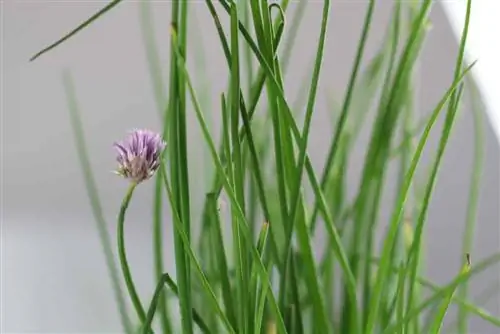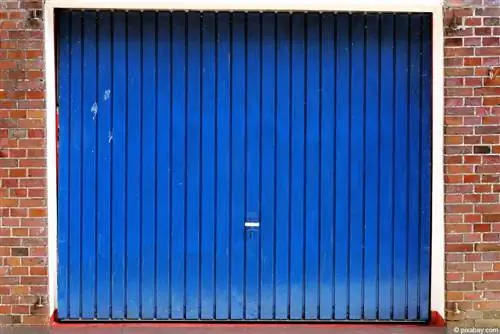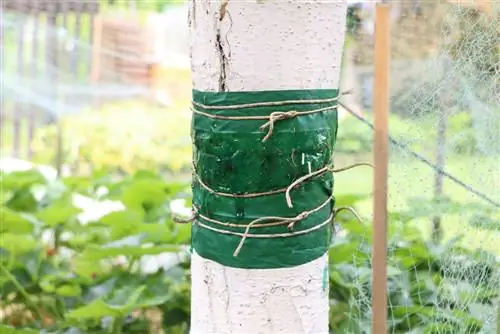- Author admin [email protected].
- Public 2023-12-17 03:39.
- Last modified 2025-01-24 12:45.
Heat, cold, snow and hail leave their mark on garage doors over the years. In addition, there are many pushes or kicks. All of this has a lasting impact on the quality of the surface. The result is scratches, rust spots and peeling paint. Now it's time for a new coat of paint.
Trade offers a wide range of different materials for garage doors. These can be made of steel, stainless steel, wood or aluminum. But galvanized gates are also not uncommon. Depending on the material, the surfaces are prepared differently for painting.
Tip:
The ideal painting temperature for any material is 20 °C. This means the paint retains its consistency and dries quickly. Avoid direct sunlight.
Painting galvanized garage door
In general, preparation is one of the most important prerequisites for successfully painting the garage door. For galvanized garage doors, the surface is cleaned of dust and dirt using zinc cleaner, ammonia solution and a little dishwashing liquid. To do this, the surface is processed with an abrasive fleece until a fine, usually gray foam forms. It is important to wear protective gloves during this preparation. After ten minutes of exposure, the surface is rinsed with clear water and chipped old paint is removed with a spatula. The surface is then lightly sanded with a sander.
After the preparations have been completed, the galvanized garage door can be primed. For this purpose, a special zinc adhesive paint is chosen. After drying, the garage door is painted with the appropriate paint. Painting the narrow spaces is best done with a round brush. A foam roller is used to process the surfaces. This ensures consistent results.
Tip:
If you use garage door paint, you don't have to give your galvanized door a primer. If metal protection paint is to be applied, galvanized garage doors require a special adhesive primer.
Painting a garage door made of sheet steel
A metal garage door also needs to be well prepared for painting. The following steps are necessary:
- First, all dust and dirt such as grease residue and s alt deposits are removed.
- The door surface is removed from loose old paint using a wire brush and sandpaper.
- If these cannot be removed, the surface should be sanded as much as possible.
- Then degrease and clean the surface with a metal cleaner.
- Treat rust spots spot by spot with rust blocker.
- Slightly roughen very smooth surfaces with sandpaper.
After the primer has hardened, sand the surface again with sandpaper. A suitable colored varnish is now applied for painting depending on the metal. As a rule, water-thinned acrylic paints are applied in two steps. On top of these two layers there is a layer of transparent top coat. This should be high-gloss or at least satin matt.
Tip:
Depending on how the garage door is constructed, the paint should be applied evenly either from top to bottom or from left to right.
Painting a wooden garage door
Wooden garage doors are very trendy because they give the property an extraordinary charm. Mahogany, merbau and red cedar are among the most popular types of solid wood for garage doors. Nevertheless, even with wooden gate surfaces, thorough preparation is essential and at the same time very time-consuming.
- First, the old paint must be completely removed, as the new paint will not stick to dissolved paint particles.
- Simply remove the coarse paint and varnish residues with the brush.
- Sandpaper with the appropriate grain size or the use of a sander are suitable for fine work.
- The narrow gaps are removed using handy grinding tools.
- In the last step, thoroughly remove the sanding dust.
After preparation, the first coat of paint is the primer. This is done using acrylic wood insulation. Regarding the drying time, the manufacturer's instructions must be followed. A suitable wood stain can then be applied. Finally, the final coat is applied with an appropriate protective varnish.
Tip:
So that wooden gates do not absorb moisture or moisture, they are painted on the inside with a sealing paint.
Painting aluminum garage door
In order to paint an aluminum garage door, it must be specially prepared. It is also strongly advisable to only use products that are specifically designed for the non-ferrous metal.
- Because aluminum is known to form an oxide layer on the surface, paints and varnishes have difficulty adhering. As a result, this layer must be completely removed before the aluminum gate gets a new coat of paint.
- The surface should be sanded with fine sandpaper (120 grit) and abrasive fleece.
- Carefully remove any remaining silicone and grease. Either with thinner or with a special cleaner.
- Then allow to dry completely.
- Shortly before priming, the surface is wiped again with a duster.
An adhesion promoter is applied as a primer. Depending on the manufacturer's instructions, the drying time must be taken into account. After priming, painting is carried out in two steps. First, a base coat (water-based paint system) is applied. Before the top coat can be painted, the base coat must dry according to the manufacturer's instructions. The top coat serves as a seal and protects the aluminum gate from the effects of the weather.
Painting a plastic garage door
Garage doors are sometimes made of plastic. If a few aspects are taken into account, these can also be painted. However, before the plastic gates can be painted, they must be cleaned of any dirt and other contamination. To do this, the surface is wiped with a damp cloth. A few squirts of detergent in the cleaning water will help against stubborn stains. Plastic garage doors should not be sanded before painting as this will cause unsightly scratches to form on the surface. Light sanding is recommended.
Plastic-coated garage doors can then be painted or sprayed with the appropriate color. When spraying, the paint is first sprayed onto a piece of newspaper and then onto the surface without settling at a distance of 30 cm. This way you can avoid unsightly drips. After drying, check for unevenness and if necessary treat the surface again with the paint spray.
What you should know about painting garage doors in brief
- A wooden garage door is very different to paint than a metal one.
- The following applies to both: It is best to paint when the outside temperature is around 20 °C so that the paint retains a good consistency and dries quickly.
Metal garage door
- In general, there is a large selection of different varnishes that can be worked with.
- You can choose between special paints for garage doors, but normal metal paint can also be used.
- The advantage of garage door paint is that it can be painted directly onto zinc, while other paints require a primer.
- It is particularly important to thoroughly clean the garage door before painting. Old paint must be carefully removed with sandpaper.
- Grease and s alt deposits as well as other dirt must be carefully removed using appropriate cleaning agents.
- The surface is then cleaned with a special metal cleaner and degreased.
- Rusted areas should be rubbed with a rust blocker so that the rust cannot eat through the new garage door paint.
- Important when painting with a flat brush: It must be painted evenly from top to bottom.
- The first coat should then have around 2 hours to dry before the second coat of paint is applied.
- Depending on the paint, a third coat may also be required.
- Between applying the different layers, the brush and, if necessary, paint roller must be washed out well.
Tip:
If the garage door is made of another metal, such as aluminum, a so-called adhesive primer must be applied as a primer before the painting process. For powder- or plastic-coated garage doors, an even more special pretreatment is necessary, for which it is best to consult a specialist.
Wooden garage door
- When repainting a wooden garage door, as with a metal door, the old surface must first be thoroughly removed.
- The old paint can be roughly removed with a wire brush and sandpaper.
- The remaining paint can be sanded off with a machine (or manually).
- The brush attachment of a drill can be used for the narrow areas between the joints.
- Once the old paint is removed, a layer of acrylic wood insulating primer is applied.
- It is also recommended to finally treat the garage door with window and door glaze, as thick-layered glazes are more durable than thin-layered ones.
- Of course, normal wood protection glaze can also be used.






